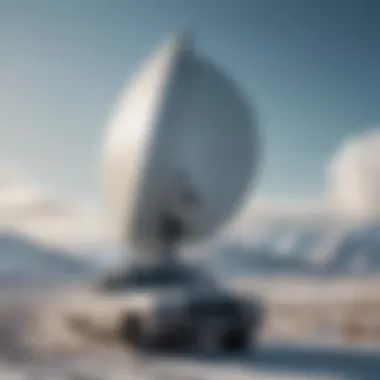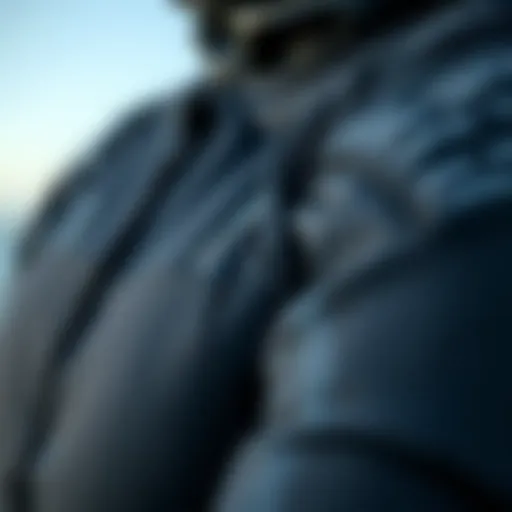Stuart Radar Weather: Understanding Its Impact


Intro
Understanding Stuart radar weather technology is akin to peeling an onion—there are layers of information, insights, and implications to uncover. At its core, this technological advancement offers more than just a way to predict rain; it has become an essential tool in various outdoor activities like kiteboarding. Picture this: you’re gliding across azure waters, the wind at your back, but a storm is brewing on the horizon. That’s where Stuart radar weather steps in, providing essential data to make informed decisions.
As we traverse this intricate landscape of radar technology, we’ll delve into how it functions, the nuances of data interpretation, and its real-world applications. Whether you're an experienced kiteboarder or someone looking to plunge into outdoor adventures, grasping these concepts can enhance your interactions with nature.
In the sections that follow, we’ll explore the gear that complements radar insights, techniques and tips for safer experiences, and leave no stone unturned in discussing its future trends. It’s a comprehensive guide tailored for enthusiasts ready to navigate the waves of uncertainty in outdoor climates.
Preface to Radar Weather Technology
In the world of meteorology, radar weather technology stands as a cornerstone, enabling experts and enthusiasts alike to decipher the complexities of atmospheric phenomena. Understanding radar technology holds great significance in accurately predicting weather patterns, which in turn supports critical decision-making for outdoor activities. This is especially vital in recreational pursuits such as kiteboarding, where real-time data can mean the difference between a thrilling day on the water and a potential disaster.
Fundamentals of Radar Technology
Radar technology operates on the simple yet powerful principle of sending out radio waves and analyzing the signals that bounce back. These radio waves travel through the atmosphere and when they encounter precipitation or other objects, they reflect back to the radar system. The information gathered includes direction, distance, and intensity of the weather phenomena. This data is then processed to create meaningful visual representations that help interpret current atmospheric conditions.
One of the essential aspects of radar functionality is its ability to detect not only the location but also the intensity of precipitation. For example, when kiteboarders monitor radar images, they can see storm cells forming and heading towards the area, which informs their choice to either stay and ride or pack it in for the day. The longitudinal reach and real-time updates provided by radar technology are invaluable, particularly when unpredictable weather can change in the blink of an eye.
Historical Evolution of Weather Radar
The journey of weather radar technology is quite fascinating and spans many decades. Initially developed during the World War II era for military purposes, radar was finally repurposed for meteorology in the 1950s. Early systems were rudimentary; however, they paved the way for advancements that have led to today's sophisticated networks.
Over the years, the technology has undergone significant transformation. In the 1980s, Doppler radar was introduced, enabling meteorologists to not just scan for precipitation but also to measure the movement of rain and wind. This advancement allowed for enhanced forecasting of severe weather conditions such as tornadoes and hurricanes. Today, digital radar systems with higher resolutions have been deployed, providing much clearer images of weather patterns and creating a much more comprehensive understanding of atmospheric behaviors.
"The evolution of radar technology has been nothing short of revolutionary; it has transformed our ability to understand and predict weather patterns."
This historical context sets the stage for further exploration into specific applications and implications of radar technology in various fields, including those affecting outdoor adventurers like kiteboarders and travelers. As we delve deeper into the workings of Stuart Radar, we’ll uncover how its unique capabilities are tailored to meet the demands of real-time weather monitoring.
Understanding Stuart Radar
In understanding Stuart radar, one must consider both the local geographic and atmospheric dynamics that contribute to weather phenomena in the region. This section unmasks the nuances of radar technology and its pivotal role in tracking weather behaviors that directly affect outdoor activities such as kiteboarding—activities reliant on accurate atmospheric predictions for safety and enjoyment.
Geographic and Atmospheric Features of Stuart
Stuart, located along Florida's Treasure Coast, boasts a unique blend of coastal geography and a tropical climate. Its proximity to the Atlantic Ocean means that moisture-laden winds significantly influence the local weather patterns. The region's varied topography, including flatlands and waterways, creates microclimates that are often challenging for traditional forecasting methods.
Understanding these geographic features is essential because they contribute to developing localized weather patterns. For instance, storms often gain strength as they move over warm waters, leading to unexpected changes in wind direction and intensity. Here’s how the local geography interacts with the radar technology:
- Moisture Flux: The radar can detect changes in humidity levels, informing users about likely rain or thunderstorm development.
- Topographical Impact: The radar systems in the area must consider how features like rivers and islands can disrupt or enhance weather phenomena.
In terms of atmospheric elements, Stuart experiences seasonality that affects temperature and precipitation. The summer months bring heavy rainfall and thermal convection, ideal for assessing how radar interprets storm systems. Understanding these specifics enables kiteboarders and outdoor enthusiasts to plan activities with respect to forthcoming weather trends.
Types of Radar Systems Used in Stuart
Radar systems serve as the eyes in the sky, enabling meteorologists to gather real-time data about weather conditions. In Stuart, several radar systems are in operation, each serving different purposes and bringing forth a wealth of information about the atmosphere. The two principal radar types include:
- Doppler Radar: This technology measures the frequency change of radar signals to ascertain wind speed and direction. In Stuart, it plays a vital role in detecting severe weather conditions, providing crucial information on storm rotation and potential tornado development.
- Dual-Polarization Radar: Offering more detailed data, dual-polarization radar sends out signals in both horizontal and vertical orientations. This allows for better differentiation between precipitation types, such as rain, snow, or hail, making it particularly useful for understanding sudden shifts in weather.
The combination of these radar systems ensures robust monitoring capabilities, giving users the necessary data to make informed decisions while planning outdoor activities, especially for those who enjoy kiteboarding.
"In many cases, access to accurate weather predictions can be the difference between a perfect day on the water or a chaotic struggle against nature."
Through these systems, radar technology not only enhances forecasting accuracy but equips the community with timely alerts, increasing overall safety for adventurers in the region.
Data Collection and Processing
The data collection and processing phase stands as a cornerstone of Stuart Radar Weather technology. It is during this stage that raw radar signals get transformed into meaningful information that can guide decisions, particularly for those involved in outdoor activities like kiteboarding. Understanding how this process works not only heightens awareness among enthusiasts but also sharpens their decision-making skills, which can be critical when dealing with unpredictable weather.
Radar Signal Transmission and Reception
In the world of weather radar, signal transmission and reception are akin to a conductor leading an orchestra. Radar systems emit electromagnetic waves that bounce off precipitation particles—think rain or snow—in the atmosphere. When these waves reflect back to the radar, the shift in frequency reveals essential details about the intensity and motion of the weather. This interaction is fascinating and underscores how essential radar is for precise data collection.
As these radar signals travel, they face various atmospheric conditions that can affect their clarity. For kiteboarders and outdoor enthusiasts, being aware of these variables becomes vital. The type of precipitation, the size of the droplets, and even the wind direction can influence signal quality. If the radar isn’t tuned properly, it could lead to misconstrued data.
Here are some specific elements to keep in mind regarding radar signal transmission and reception:


- Frequency: Different radar systems operate on different frequencies, which can impact their ability to detect certain weather conditions.
- Distance: Closer precipitation allows for a clearer signal. Distal weather patterns may be harder to decode, leading to unreliable forecasts.
- Interference: Signals from buildings or mountains can interfere with transmission, leading to holes in the data.
Data Processing Algorithms
Once the radar signals are received, the real magic happens through data processing algorithms. These algorithms analyze and convert the received signals into images and data that meteorologists and enthusiasts can interpret. Think of these algorithms as a sophisticated filtering system that separates the wheat from the chaff, ensuring only the most relevant information gets through.
The processing involves various steps:
- Signal Filtering: Raw data contains noise. Advanced filtering techniques sift out irrelevant signals to enhance data quality.
- Visualization: The processed information is translated into visual representations, such as reflectivity maps showing precipitation intensity and movement.
- Weather Modeling: Algorithms incorporate historical data and predictive analysis, allowing users to foresee upcoming weather events and adjust their plans accordingly.
Algorithm sophistication directly impacts forecasting accuracy. For outdoor activities, especially kiteboarding, knowing real-time weather conditions can mean the difference between a fun day on the water and a risky situation.
"To make informed decisions, we need clear, actionable weather data. Radar processing is what turns chaos into clarity."
From this we see that understanding how data collection and processing occurs opens a window to the decisions outdoor enthusiasts will need to make. Whether you’re steering your kite or planning a trip, the quality of radar data can significantly affect your experience.
Interpreting Radar Images
Understanding and interpreting radar images is crucial for both meteorologists and outdoor enthusiasts alike. It’s not just about seeing the colors and shapes floating on a screen; it’s about grasping the real-time implications that these visuals have on weather forecasting and safety. For kiteboarders and other outdoor adventurers, this can mean the difference between a thrilling day on the water and a dangerous situation caused by unexpected weather changes.
Understanding Reflectivity and Velocity
Reflectivity and velocity are two of the pillars that pro up radar images. Reflectivity indicates the intensity of precipitation. Simply put, brighter shades often mean heavier rain. This makes it essential for predicting not just sudden downpours but also the potential for storms.
Velocity, on the other hand, is like the weather's pulse. It informs about the movement of precipitation—moving toward or away from the radar site. Understanding this dynamic helps kiteboarders assess wind shifts that could make or break their experience on the water.
Why is this important? Well, when a radar image shows high reflectivity coupled with rapid velocity changes, it might be signaling a developing storm or severe weather event. This understanding is pivotal for preemptive measures in planning outdoor activities.
Analyzing Weather Patterns through Radar
Radar is not just about immediate precipitation; it also gives insights into broader weather patterns. By analyzing time-sequenced radar images, one can discern how storms are evolving, which areas are most affected, and, critically, where the clearings might be.
Radar images can depict multiple layers of data. For example:
- Storm tracks: Understanding the trajectory helps in predicting how weather will impact outdoor plans.
- Wind shear: Identifying sudden changes in wind direction or speed is vital for safety, especially for those engaged in activities like kiteboarding.
- Temperature gradients: These can indicate where different weather systems meet, which is often where storms intensify or dissipate.
"Radar technology allows us to not just predict the weather, but understand the environment we are a part of. Awareness is half the battle in outdoor activities!"
The interpretation of radar images tells a story. Grasping that narrative empowers kiteboarders, instructors, and hobbyists to make more informed decisions, ensuring their adventures remain enjoyable and safe. Ultimately, the value of radar interpretation lies in its ability to transform a simple visual into actionable insights, reinforcing the importance of seasoned observation in outdoor pursuits.
Stuart Radar Applications
In today's rapidly changing atmospheric conditions, the Stuart radar applications play a crucial role in meteorology, particularly in enhancing our understanding of weather systems. This section delves into the multifaceted benefits and vital components of Stuart Radar, particularly for those involved in outdoor pursuits. Understanding these applications not only enhances safety but also improves decision-making processes for enthusiasts and professionals alike.
Impacts on Weather Forecasting
Weather forecasting has come a long way. Its evolution owes much to advanced technologies like radar. Stuart Radar in particular, allows meteorologists to access real-time data, which is paramount when predicting weather events. The technology captures precipitation and wind movements with remarkable precision. With these capabilities, forecasters can inform communities about impending storms or unusual weather patterns long before they arrive.
- Real-time Monitoring: Stuart Radar can track weather systems as they develop. This means timely updates are possible, essential for public safety.
- Enhanced Accuracy: Traditional forecasting methods may fall short. Radar provides critical data, refining the accuracy of predictions and enabling more reliable forecasts of severe weather events.
- Localized Insights: Unlike some broader forecasting techniques, Stuart Radar can detect localized changes in conditions. For example, it helps in identifying microclimates, ensuring that areas prone to sudden storms are given adequate warnings.
To summarize, the impact of Stuart Radar on weather forecasting is profound. Its continuous data stream facilitates decisions that can save lives and property.
Influence on Outdoor Activities
Outdoor activities and weather conditions share an intimate relationship. Kiteboarding, hiking, and various forms of recreation depend heavily on weather awareness. Stuart Radar ensures participants have the critical information they need before embarking on an adventure.
- Kiteboarding Safety: Kiteboarders require keen insight into wind patterns and storm developments. Utilizing Stuart Radar, these enthusiasts can monitor real-time conditions close to their launch spots, ensuring they do not expose themselves to dangerous circumstances.
- Informed Decision-Making: For travelers and outdoor aficionados, leveraging accurate radar data means they can plan outings effectively. Having access to precise weather information allows individuals to avoid inclement weather, which is especially significant for those venturing into wilderness areas.
Overall, the influence of Stuart Radar on outdoor activities is unmistakable. This technology empowers individuals with the knowledge they need to enjoy their pursuits safely and responsibly. As the understanding of radar applications in recreational settings deepens, so too does the effectiveness of using this knowledge in daily activities.
Safety Implications
Radar weather technology plays a critical role in the overall safety of outdoor activities, especially in a place like Stuart. It brings significant benefits, offering real-time awareness of changing weather conditions that can affect enthusiasts, adventurers, and locals alike. The predictive capabilities of radar data enable timely reactions that can mean the difference between a thrilling experience and a dangerous situation.
Understanding this section is essential, because weather patterns can shift like a fickle friend. Rains can come pouring down one moment and clear skies can follow in the next. Therefore, depending solely on intuition isn’t a wise move when outdoors.
The technology itself isn’t just a bunch of fancy equipment. It leverages waves, which bounce off of moisture in the atmosphere, processing this data to give clear and actionable insights. These insights, in turn, lead to effective decision-making when it matters most, ensuring safety for those indulging in activities like kiteboarding or simply enjoying the outdoors.


Weather Alerts and Notifications
Stuart radar weather systems are at the forefront of disseminating weather alerts and notifications. When a storm looms or conditions become hazardous, users are notified almost instantly through various platforms. This ensures that kiteboarders, travelers, and community members receive accurate and timely updates.
Consider how critical this is for kiteboarders, whose recreational activity strikes a delicate balance between thrill and risk. A well-timed weather alert can keep them grounded safely when high winds or storms threaten to toss them into treacherous conditions. Some key features include:
- Real-Time Updates: Immediate alerts that notify users of severe weather changes.
- Multiple Channels: Information sent via text messages, apps, or even social media platforms—ensuring broader reach.
- Personalized Notifications: Options allowing users to choose what alerts matter most to them.
"In an ever-changing climate, quick notifications stand as a lifeline for many outdoor enthusiasts."
By prioritizing such alerts, the local community cultivates a culture of safety and awareness. Outfitting users with timely notifications allows for proactive rather than reactive responses to severe weather.
Impact on Kiteboarding Safety Procedures
When it comes to kiteboarding, the stakes are high. Safety procedures depend heavily on accurate weather forecasting. In Stuart, radar technology has profoundly influenced how safety protocols are developed and executed. The fabric of kiteboarding safety now intricately weaves in the precision of radar systems.
Kiteboarding instructors and enthusiasts are utilizing radar data to streamline safety checks before hitting the water. Procedures influenced by radar include:
- Pre-Flight Weather Assessments: Assessing radar images before sessions ensures all are aware of the current wind and storm conditions.
- Dynamic Risk Management: If conditions change mid-session, quick access to radar data allows for faster decision-making needed to call it a day.
- Training and Education: New kiteboarders are being taught the importance of radar data in their safety briefings, reinforcing their role in personal responsibility.
Furthermore, club organizations have established safety guidelines based on radar reporting. These guidelines ensure that everyone, from newbies to seasoned pros, is equipped with the knowledge to respond to developing weather conditions—making the waters of Stuart safer.
In summary, understanding the implications of radar technology on safety invites a closer relationship between weather information and community activities. With swift alerts and impact on kiteboarding practices, the community stands stronger, more aware, and undeniably safer.
Comparative Analysis
In the realm of weather monitoring, comparative analysis plays a vital role in understanding the capabilities and limitations of different meteorological technologies. Within the scope of this article, it provides insights into how Stuart Radar distinctively performs against other weather observation systems. This method of evaluation enlightens enthusiasts, like kiteboarders and adventurers, about the best tools available for their safety and preparation.
The comparative analysis allows one to critically assess how various systems measure up, not just in terms of meteorological accuracy but also in application functionality. Understanding the benefits and quirks of each system can inform decisions that affect outdoor activities. Specifically, when engaging with weather technology like Stuart Radar, one is better equipped to interpret forecasts and make educated choices concerning outdoor ventures.
Comparison with Other Weather Monitoring Systems
When comparing Stuart Radar to other weather monitoring systems, several key differences come into focus. For instance, while traditional weather stations rely on surface observations and can be somewhat limited in their regional scope, radar systems like Stuart offer a broader perspective by analyzing atmospheric conditions up in the air as well. This can cover things like precipitation movement, storm dynamics, and even wind patterns at different altitudes.
A few notable types of weather monitoring systems include:
- Satellite Observation: Satellites provide global coverage and can capture vast weather patterns. However, they often lack the detail of localized phenomena that radar systems provide, such as identifying exact storm paths.
- Weather Balloons: These can give fantastic profile data about the atmosphere but can be expensive to deploy and require specific launching sites. In contrast, radar technology offers continuous monitoring without physical deployment.
- Ground-Based Stations: While beneficial in providing local weather reports, they typically can't detect severe weather conditions at a distance. Radar, particularly Stuart, enhances the forecasting game significantly by offering alerts before conditions escalate.
Strengths and Limitations of Radar Technology
Radar technology, as seen with Stuart Radar, undoubtedly has its strengths, but understanding its limitations is equally crucial. On the strength side, radar systems provide real-time feedback, allowing users to receive timely information about incoming weather. This is especially beneficial for kiteboarders and outdoor enthusiasts who need to make quick decisions based on changing weather patterns.
Some notable strengths include:
- High Resolution: Radar can deliver detailed images of precipitation and storm structure, supplying a wealth of information that can drive alert systems and forecasting.
- Predictive Capabilities: With advanced algorithms and models, radar can predict weather shifts before they hit, aiding safety decisions for outdoor activities.
However, radar technology is not without its flaws. Certain limitations also need consideration:
- Range Limitations: Depending on the local geography, radar may not always capture weather events accurately beyond a specific radius. For example, areas shielded by mountains could experience gaps in data.
- False Positives/Negatives: The technology might occasionally misinterpret data leading to alerts for non-existent storms or missing actual severe weather incidents.
In summary, thorough comparative analysis of Stuart Radar against other weather monitoring systems highlights both its strengths in real-time monitoring and predictive capabilities while also recognizing its limitations, such as range and potential inaccuracies. This nuanced understanding empowers adventurers to navigate their environments with heightened awareness and improved decision-making skills.
Future Trends in Weather Radar
As we look to the horizon, the landscape of weather radar technology appears to be in a state of vibrant flux, characterized by innovation and evolution. Understanding the future trends in weather radar is not merely a matter of technological curiosity; it’s essential for anyone engaged in outdoor activities. Kiteboarders, instructors, adventurers — all depend on accurate weather forecasting to optimize their experiences while simultaneously ensuring their safety. By delving into this subject, we appreciate the ways in which emerging technologies and enhancements in data integration can reshape our interactions with the environment.
Emerging Technologies in Radar Systems
Emerging technologies in radar systems promise to bring forth substantial advancements in monitoring and predicting weather patterns. One significant trend is the integration of Doppler radar technology with Artificial Intelligence (AI) capabilities. The combination allows for more accurate tracking of severe weather systems, enhancing the ability to predict storms well in advance.
A few key advancements worth considering include:
- Phased Array Radars: Unlike traditional radar systems which rotate, phased array radars can electronically steer beams at multiple angles. This results in faster acquisition of data and greater resolution, making it an invaluable tool in storm tracking.
- Miniaturization of Radar: As technology progresses, smaller and more portable radar systems are being developed. These can be easily deployed around various geographic locations, making it possible to gather localized weather data in real-time. This is particularly useful for kiteboarders who may want to check conditions along different stretches of the coastline.
"The integration of advanced radar technologies into our weather systems enables us to make informed, timely decisions, especially for outdoor activities that depend heavily on the weather."


Potential Advances in Data Integration
The future of weather radar does not just hinge on the radar systems themselves but also on how data from these systems are processed and integrated. Potential advances in data integration are likely to yield significant benefits for weather forecasting.
- Big Data Analytics: The accumulation of vast amounts of weather-related data poses unique opportunities and challenges. Enhanced data analytics will allow for deep learning algorithms to sift through this information, identifying patterns that traditional methods might miss. For kiteboarders, this could mean more refined forecasts tailored to specific activities.
- Real-Time Data Sharing: As systems become more interconnected, the capacity for real-time data sharing will transform the way information is disseminated. This means that weather updates could be pushed to smartphones or other devices instantly, enabling individuals to make last-minute decisions based on the most current information.
- User-Generated Data: Crowdsourced contributions can enrich the available data pool. Platforms that allow users to input weather condition updates can complement radar data, creating a more comprehensive picture of the weather. This is especially beneficial in areas where radar coverage might be lacking.
Case Studies
Case studies play an essential role in illustrating the practical applications of Stuart radar technology in real-world scenarios. This segment dives into how we can analyze recent weather events and glean lessons from historical data. By studying these instances, kiteboarders, outdoor enthusiasts, and meteorological professionals alike can draw valuable insights that enhance safety and decision-making in weather-sensitive activities.
Recent Weather Events Analyzed via Stuart Radar
Exploring the most recent weather events provides context to how Stuart radar systems operate in practice. One standout analysis involved severe thunderstorms that swept through Stuart last summer. The radar captured real-time data, providing vital information on storm movements, intensity, and potential hazards.
Radar technology enabled meteorologists to issue timely warnings about lightning strikes and heavy rainfall. In one event, radar data showed rapidly developing storm cells, highlighted by bright red areas indicating high intensity. This early warning allowed kiteboarders to evacuate the area and avoid life-threatening conditions.
Key benefits of analyzing recent weather events include:
- Real-time Data Availability: Immediate access to weather changes improves safety and preparedness.
- Enhanced Forecast Accuracy: By studying data patterns, forecasts for upcoming weather events can be refined.
- User Guidance: Data-driven insights can inform kiteboarders and adventurers about optimal weather windows.
Notably, social media platforms like Reddit erupted as community members shared experiences and insights from their own perspectives during the storms, highlighting how local knowledge complements radar data.
Lessons Learned from Historical Data
Historical data serves as a treasure trove of insights into how weather systems behave over time. By analyzing past weather patterns observed through Stuart radar, we can identify trends that help mitigate risks during outdoor activities. For example, reviewing radar imagery from previous hurricane seasons reveals patterns in storm formation and trajectory, which can significantly affect safety protocols for kiteboarding.
From one particular hurricane that hit the region years ago, analysts noted that wind patterns shifted dramatically just before the storm's arrival. This prompted local authorities to update their safety guidelines. As a result, kiteboarders learned to stay clear of certain areas known for generating dangerous currents during such events.
Several considerations when examining historical data include:
- Long-term Trends: Understanding how weather patterns have changed over decades can provide a more comprehensive perspective.
- Impact Assessment: Evaluating how previous events impacted local communities enhances preparedness measures.
- Data-Driven Safety Recommendations: Historical insights can lead to more defined safety protocols for planning outdoor activities.
"Data is not just numbers; it's the pattern of events that shows us how to read the skies."
Community Engagement and User Interaction
Engaging the community in weather dynamics is paramount, especially for meteorological tools like radar systems. Understanding local atmospheric patterns not only enriches data quality but also fosters a unique amalgamation of shared experiences. For kiteboarders, instructors, travelers, and adventurers, having a strong network of information exchange dramatically enhances their decision-making capabilities. They can benefit from real-time insights from other users, thus contextualizing the data from radar technology for specific outdoor activities.
User Contributions to Weather Data Analysis
When it comes to interpreting weather data, nobody knows the local quirks better than the residents themselves. Users can contribute their real-time observations and experiences alongside the radar data, creating a valuable database of localized weather conditions. Whether it's reporting a sudden gust of wind or a shift in storm patterns, these insights add layers of understanding that pure data often misses.
- Crowdsourcing Information: Engaging local kiteboarders can lead to accurate, crowd-sourced weather insights that are timely and relevant.
- Enhances Forecast Accuracy: Real-life observations contribute to improving computerized weather forecasts. The fusion of raw radar readings with user data provides a fuller picture of the current conditions.
Engaging users in this way creates a community wherein everyone can contribute towards a common goal: safe and enjoyable outdoor activities like kiteboarding.
Forums for Kiteboarding and Weather Discussion
The digital landscape has created a haven for kiteboarders and weather enthusiasts alike, promoting forums that focus on the intersection of meteorological conditions and the sport itself. These forums have become bustling hubs of conversation, where enthusiasts capture and share weather predictions, personal anecdote, and radar data.
- Knowledge Sharing: Here, users swap tips on how to read radar imagery and interpret data, aiding in better preparedness for kiteboard sessions.
- Event Planning: The real-time discussions in these forums often help coordinate kiteboarding meetups, allowing for a community-driven approach to enjoying water sports.
"Staying ahead of weather patterns makes all the difference; it’s like having an insider's ticket to the best kiteboarding spots."
Participants in these forums often exchange links to live feeds or reports from Stuart radar data, enhancing the quality of information available to everyone. By integrating these insights with personal experiences, communities are not just engaged; they are empowered, elucidating their paths on windy days with precision.
Closure
In wrapping up our exploration of Stuart radar weather technology, it becomes clear that its role extends beyond mere data collection and transmission. It serves a crucial part in enhancing safety and decision-making for outdoor activities, with kiteboarding being a prime example. Accurate and timely weather data can mean the difference between a thrilling adventure and a perilous situation.
Recap of Key Insights
As we've traversed through the multifaceted aspects of Stuart radar, several key points emerged:
- Precision and Clarity: Stuart radar systems provide high-resolution images that help users interpret weather conditions with remarkable clarity. This feature is particularly beneficial for kiteboarding enthusiasts who depend on real-time insights.
- Data Integration with User Contributions: The capability for community engagement in weather data analysis enhances the reliability of forecast models. Users can contribute by sharing their experiences and updating real-time weather assessments.
- Significant Impact on Forecasting: The advancements in radar technology have revolutionized weather forecasting, allowing for structures like storm tracking and predictive analytics to be more accurate than ever, which is vital for outdoor sports planning.
Final Thoughts on Radar Technology's Role
As we look forward, the evolution of radar technology in meteorology paints an optimistic picture. With continued innovations, we can expect enhancements in data integration, machine learning applications, and predictive modeling. These will not just refine the way we view weather patterns; they will redefine our approaches to outdoor activities.
Moreover, user interaction plays an essential part in shaping the future of radar systems. Forums such as Reddit, for example, can be valuable spaces for kiteboarders and adventure-seekers to exchange information and strategies based on weather forecasts and radar data.
Ultimately, understanding and leveraging Stuart radar weather technology is paramount for anyone interested in outdoor activities. This knowledge equips adventurers with the tools needed to explore safely and intelligently, acknowledging that nature's whims can be as unpredictable as they are exhilarating.















